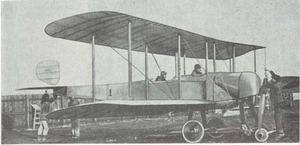Loading AI tools
From Wikipedia, the free encyclopedia
The Bristol T.B.8, or Bristol-Coanda T.B.8 was an early British biplane built by the Bristol Aeroplane Company and designed by the Romanian Henri Coandă. Fifty four Bristol T.B.8s were built, being mainly used as a trainer. A small number of Bristol T.B.8s were briefly used as bombers at the start of the World War I by the Royal Naval Air Service.
| T.B.8 | |
|---|---|
 A Bristol T.B.8 at Cotroceni | |
| General information | |
| Type | Trainer/Bomber |
| Manufacturer | Bristol Aeroplane Company |
| Designer | |
| Primary users | Royal Naval Air Service |
| Number built | 54 |
| History | |
| Introduction date | 1913 |
| First flight | 12 August 1913 |
| Retired | 1916 |
| Developed from | Bristol-Coanda Monoplanes |
Romanian Henri Coandă, chief designer of the Bristol Aeroplane Company, developed the Bristol T.B.8 as a biplane conversion of his previously designed Bristol-Coanda Monoplane. The conversion was made to meet an order from the British Admiralty, with the Bristol T.B.8 first flying on 12 August 1913.[1] This aircraft was tested with both wheeled undercarriage and floats.
The Bristol T.B.8 was a single-engined, two-seat biplane, with two-bay wings and a slender fuselage. It was powered by a variety of rotary engines, including the Gnome and Le Rhône engines with power ranging from 50 hp Gnomes to 100 hp Gnome Monosoupape.[2] Early Bristol T.B.8s used wing warping, with later production aircraft being fitted with ailerons. Bristol T.B.8s were normally equipped with a distinctive four wheel undercarriage. The Bristol T.B.8 was produced by both the conversion of existing Coanda-Bristol Monoplanes and the manufacturing of new aircraft.

One Bristol T.B.8 was fitted with a prismatic Bombsight in the front cockpit and a cylindrical bomb carrier in the lower forward fuselage, capable of carrying twelve 10 lb (4.5 kg) bombs, which could be dropped singly or as a salvo as required.[1] This aircraft was displayed at the Paris Salon de l'Aéronautique and evaluated by the French military before being purchased by the Royal Navy Air Service.
Bristol T.B.8s were purchased for use both by the Royal Naval Air Service and the Royal Flying Corps, with the Royal Flying Corp's Bristol T.B.8s being transferred to the Royal Navy Air Service shortly after the start of World War I.[1] Three Bristol T.B.8s, including the aircraft displayed at the Paris Air Show in December 1913, were sent to France following the outbreak of World War I, serving with a Royal Navy Air Service squadron commanded by Charles Rumney Samson. One of these Bristol T.B.8s executed a bombing attack on German gun batteries at Middelkerke Belgium on 25 November 1914, with the attack being the only bombing sortie flown by the Bristol T.B.8.[1] The Bristol T.B.8 was considered too slow for frontline operations, and was relegated to training operations, serving until 1916.[3][4]


Data from Bristol Aircraft Since 1910 [2]
General characteristics
Performance
Armament
Seamless Wikipedia browsing. On steroids.
Every time you click a link to Wikipedia, Wiktionary or Wikiquote in your browser's search results, it will show the modern Wikiwand interface.
Wikiwand extension is a five stars, simple, with minimum permission required to keep your browsing private, safe and transparent.